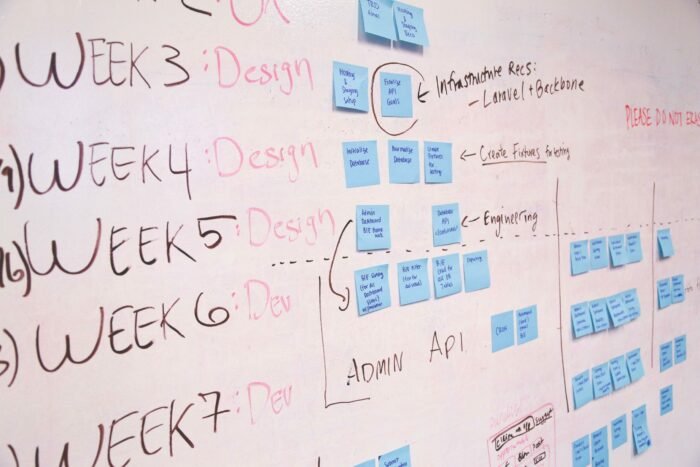Streamlining project management processes is essential for maximum efficiency and success. By using the right tools and techniques, we can identify and troubleshoot risks, improve communication, and increase employee collaboration. The project management process model includes initiation, planning, execution, monitoring, and closure phases. Streamlining involves using tactics to increase efficiency, eliminating unnecessary steps, and improving communication among team members. Automation plays a key role in streamlining processes, allowing for simultaneous project management and accurate time tracking. Effective project management and process management integration are important for achieving project goals and minimizing scope creep. Delivering results requires understanding each department’s workflow, identifying areas for improvement, testing the improved workflow, and having a solid plan in place. Effective communication and the use of the right project management tools are crucial for streamlining project management processes. Implementing risk management strategies, conducting Proper budgeting, and continuously improving the process are also important steps in streamlining project management.
Key Takeaways:
- Streamlining project management processes increases efficiency and success.
- Automation and proper tools improve communication and time tracking.
- Understanding workflows and identifying areas for improvement is crucial.
- Risk management and budgeting play important roles in streamlining processes.
- Continuously improving the process leads to better project management outcomes.
Understanding the Streamlining Process in Project Management
Streamlining the project management process involves optimizing each phase of project management to achieve maximum efficiency and success. Let’s dive into the different aspects of the streamlining process:
Project Phases
Project management consists of several phases that need to be strategically planned and executed. These phases include:
- Initiation: Defining the project’s objectives, stakeholders, and feasibility.
- Planning: Developing a comprehensive project plan that outlines scope, deliverables, timeline, and resources.
- Execution: Implementing the project plan and performing the necessary tasks to complete the project.
- Monitoring: Continuously tracking the project’s progress, identifying bottlenecks, and making timely adjustments.
- Closure: Completing the project, assessing its success, and documenting lessons learned.
Project Scope
The project scope defines the boundaries, goals, and deliverables of the project. It outlines what needs to be accomplished and identifies the constraints and limitations. By clearly defining the project scope, teams can stay focused and avoid unnecessary work that could derail the project.
project schedule
A project schedule is a timeline that details the start and completion dates of tasks within the project. It helps teams understand the sequence of activities, allocate resources effectively, and meet deadlines. With a well-defined project schedule, project managers can ensure smooth progress and timely delivery.
Project Budget
Effective budgeting is crucial for estimating the total cost of a project and allocating resources efficiently. It involves analyzing costs, estimating expenses, and monitoring expenditures throughout the project lifecycle. By maintaining a well-managed project budget, teams can avoid financial risks and ensure cost-effective project delivery.
Project Risks
Project risks are unforeseen events or uncertainties that may affect a project’s outcome. It is important to identify and assess these risks to develop appropriate mitigation strategies. By proactively managing and mitigating risks, project teams can minimize disruptions and increase the likelihood of project success.
Understanding and optimizing each aspect of the project management process, including the project phases, scope, schedule, budget, and risks, is key to streamlining project management and achieving efficiency in project delivery.
9 Steps to Streamline Your Project Management Process
If you want to achieve maximum efficiency and success in your project management process, it is crucial to streamline your workflow. By following these 9 steps, you can enhance your project management process and achieve your goals more effectively:
- Utilize the right project management tools: Choose project management tools that align with your specific needs and requirements. These tools can help you track tasks, collaborate with team members, and manage project timelines efficiently.
- Create an efficient workflow: Develop a streamlined workflow that eliminates unnecessary steps and bottlenecks. A well-organized workflow ensures that tasks are completed in a logical and efficient manner.
- Embrace effective communication: Establish clear lines of communication with your team members and stakeholders. Regularly update them on project progress, discuss any challenges, and ensure that everyone is on the same page.
- Automate repetitive tasks: Identify repetitive tasks that can be automated to save time and reduce errors. Task automation tools can help streamline your project management process and free up valuable time for more critical tasks.
- Implement risk management strategies: Proactively identify and assess potential risks that may impact your project’s success. Develop strategies to mitigate these risks and regularly monitor and evaluate the effectiveness of these strategies.
- Proper budgeting: Set a realistic budget for your project and closely monitor expenses throughout the project’s lifecycle. Keep track of costs and make adjustments as needed to ensure that the project remains within budget.
- Establish clear goals and objectives: Define clear project goals and objectives that are specific, measurable, achievable, relevant, and time-bound. This provides a clear direction for your project and helps you stay focused.
- Regularly evaluate and improve the process: Continuously evaluate your project management process to identify areas for improvement. Seek feedback from team members and stakeholders and make necessary adjustments to optimize efficiency and effectiveness.
- Empower your team: Provide your team members with the necessary resources, support, and training to excel in their roles. Empowered team members are more likely to contribute to a streamlined project management process.
By following these steps, you can streamline your project management process, enhance efficiency, and increase the likelihood of project success.
The Benefits of Streamlining Business Processes
Streamlining business processes offers a wide range of benefits that can significantly impact the success and efficiency of a company. By implementing streamlined processes, businesses can experience increased efficiency, improved communication, reduced errors, and simplified employee training. Let’s explore the key advantages in more detail:
Increased Efficiency and Productivity
Streamlining business processes eliminates unnecessary steps and bottlenecks, allowing tasks to be completed more quickly and effectively. By optimizing workflows and removing redundant activities, employees can focus their time and energy on essential tasks, resulting in increased productivity and overall operational efficiency.
Improved Communication and Collaboration
Streamlined processes facilitate better communication between teams and departments. By establishing clearly documented procedures and standardizing communication channels, information sharing becomes seamless and transparent. This leads to enhanced collaboration, reduced misunderstandings, and improved decision-making.
Reduced Errors and Rework
Streamlining processes helps identify and address potential errors early on, minimizing the occurrence of mistakes and rework. By implementing standardized procedures and utilizing automation tools, businesses can achieve greater accuracy and consistency in their operations, reducing the likelihood of costly errors and customer dissatisfaction.
Simplified Employee Training
Well-defined and streamlined processes provide employees with clear instructions and guidelines, simplifying their training and onboarding experiences. By having documented procedures and utilizing user-friendly systems, employees can quickly understand and adopt the processes, accelerating their efficiency and effectiveness in their roles.
Enhanced Accountability and Visibility
Streamlined processes ensure that responsibilities are clearly assigned, making individuals more accountable for their actions. Additionally, streamlined workflows provide visibility into the progress of tasks and projects, allowing management to identify bottlenecks, track performance metrics, and make data-driven decisions to optimize business operations.
Streamlined business processes lead to increased efficiency, improved communication, reduced errors, simplified employee training, enhanced accountability, and improved employee morale.
By streamlining business processes, organizations can enjoy a multitude of benefits, including optimized efficiency, improved communication, and reduced errors. Simplified employee training and increased accountability are additional advantages that result in enhanced overall performance and customer satisfaction. Make the most of these benefits by adopting streamlined processes tailored to your specific business needs.
Streamlining Web Development Projects
When it comes to web development projects, streamlining is key to maximizing efficiency and overcoming common challenges. By implementing project management systems and establishing a repeatable workflow, we can stay organized and minimize time-consuming tasks. Let’s take a closer look at the strategies and techniques that contribute to web development efficiency.
The Importance of Planning
The planning stage of a web development project is critical to its success. Rushing through this phase can lead to scope creep and unnecessary revisions later on. It’s essential to take the time to thoroughly understand the project requirements and set clear expectations with our clients. By doing so, we can avoid misunderstandings, save time, and ensure a smooth development process.
Identifying and Fixing Time Sinks
During the development phase, it’s important to identify and fix time sinks – tasks or processes that consume a significant amount of time without adding much value. By carefully analyzing our workflow, we can pinpoint areas where we can improve efficiency and eliminate bottlenecks. This could involve optimizing code, finding alternative solutions to complex problems, or utilizing efficient development tools.
Automating Repetitive Tasks
Automation is a powerful tool when it comes to web development efficiency. By automating repetitive tasks such as code generation, testing, and deployment, we can save valuable time and reduce the risk of errors. This allows us to focus on more complex and creative aspects of the project, ultimately delivering high-quality websites in a shorter timeframe.
Automating repetitive tasks in web development not only saves time but also minimizes the chance of human error, leading to a more efficient and reliable development process.
Utilizing Starter Sites and Development Toolkits
Starter sites and development toolkits provide a solid foundation for web development projects. These resources offer pre-designed templates, components, and functionalities that can be customized to meet specific project requirements. By leveraging these tools, we can streamline the development process, reduce development time, and ensure consistency across different projects.
Establishing a Formula for Site Launch
To ensure a polished final product, it’s important to establish a formula for site launch. This involves creating a checklist of essential tasks to be completed before launch, including testing for responsiveness, cross-browser compatibility, and functionality. By following a standardized checklist, we can avoid overlooking crucial elements and deliver websites that meet or exceed client expectations.
Incorporating these strategies into our web development projects allows us to streamline our workflow and deliver efficient, high-quality websites. By investing time in planning, optimizing processes, automating repetitive tasks, and utilizing the right tools, we can achieve web development efficiency while meeting project deadlines and client expectations.
Building an Effective Web Development Toolkit
Building an effective web development toolkit is crucial for streamlining projects and delivering exceptional websites. By utilizing the right web development tools, including page builders, practicing agile web development, and relying on reliable plugins, we can optimize our workflow and ensure efficient project management.
One essential tool for web developers is a powerful page builder. Beaver Builder, for example, offers robust features that eliminate the need for multiple plugins, saving both time and effort. With its drag-and-drop functionality and customizable templates, web developers can create stunning websites with ease.
In addition to page builders, having a reliable framework theme, such as Beaver Builder Theme, can further enhance efficiency and maintain consistent quality throughout the development process. Pairing a page builder with a framework theme ensures cohesive design elements and a seamless user experience.
Web developers should also consider other essential tools to streamline their workflow. Code editors like Sublime Text or Visual Studio Code can improve productivity and facilitate efficient coding. Local development environments like XAMPP or WAMP allow developers to test their websites locally before deployment.
Implementing version control systems such as Git enables collaboration and ensures that code changes are tracked and manageable. Additionally, debugging tools like Chrome Developer Tools can help identify and fix any issues during the development phase.
By carefully selecting and becoming proficient in using these web development tools, we can optimize our workflow, save time, and deliver exceptional websites to our clients.
Conclusion
Streamlining the project management process and web development projects is essential for small project frameworks to achieve maximum efficiency and deliver high-quality work. By implementing the right project management systems and utilizing effective tools and techniques, we can optimize our workflow, reduce errors, and save valuable time.
Throughout this article, we have explored the importance of clear expectations and establishing a solid project framework. By following the steps outlined, we can streamline our workload, enhance project management efficiency, and create an optimized workflow. This streamlined approach not only minimizes risks but also ensures that web development projects are completed within the set time frame and budget.
With the right combination of project management systems and tools, small project frameworks can achieve a streamlined development process. By utilizing efficient communication channels, task automation, and diligent risk management strategies, we can overcome challenges and deliver exceptional websites to our clients.
In conclusion, by embracing the concept of streamlining and consistently refining our project management processes, small project frameworks can achieve improved efficiency and deliver high-quality work. Through optimized workflows and streamlined development, we set ourselves up for success in the dynamic world of web development.
FAQ
What is a small project framework?
A small project framework is a structured approach to managing small projects efficiently and effectively, with a focus on streamlining processes and optimizing workflow.
How can I streamline my project management process?
To streamline your project management process, you can follow these steps: initiate the project, plan the project, execute the project tasks, monitor progress, manage risks, control the budget, and close the project successfully.
What are the benefits of streamlining business processes?
Streamlining business processes can lead to increased efficiency, improved communication, reduced errors, simplified employee training, and enhanced customer satisfaction.
How can I streamline web development projects?
To streamline web development projects, you can implement project management systems, create a repeatable workflow, set clear expectations with clients, identify and fix time sinks, automate repetitive tasks, and follow a launch checklist for a polished final product.
What tools are essential for building an effective web development toolkit?
Essential tools for building an effective web development toolkit include page builders, code editors, local development environments, version control systems, and debugging tools.









